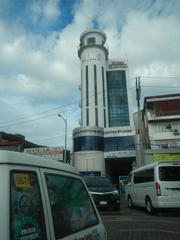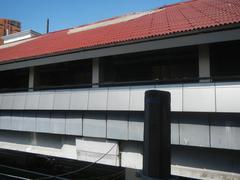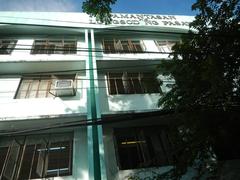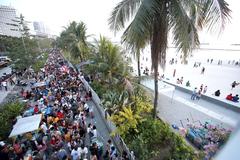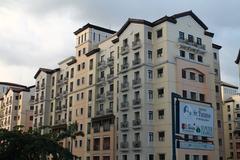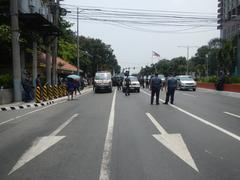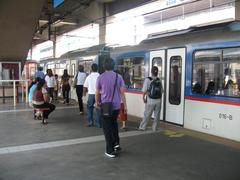
EDSA Station Visiting Hours, Tickets, and Pasay Historical Sites Guide
Date: 04/07/2025
Introduction to EDSA Station and Its Significance
Located at the intersection of Epifanio de los Santos Avenue (EDSA) and Taft Avenue in Pasay City, EDSA Station is a pivotal hub in Metro Manila’s transit network. Serving as a major transfer point between Light Rail Transit Line 1 (LRT-1) and the adjacent Metro Rail Transit Line 3 (MRT-3) Taft Avenue Station, it offers seamless connectivity for commuters, tourists, and provincial travelers. The station’s strategic location provides direct access to the Ninoy Aquino International Airport, southern provinces, and Metro Manila’s commercial centers, solidifying its importance in regional mobility (Wikipedia: EDSA station (LRT); TechPilipinas).
Since its construction in the early 1980s, EDSA Station has adapted to serve over 52,000 daily passengers, integrating various transport options—including the EDSA Carousel Busway and nearby provincial bus terminals such as Victory Liner and Philtranco. The station prioritizes accessibility with features like ramps, elevators, and wide corridors, ensuring inclusivity for all travelers (Wikipedia: EDSA station (LRT); Philippine Beaches).
Beyond transportation, EDSA Station and its namesake avenue are steeped in socio-cultural and historical significance, notably as the backdrop for the 1986 People Power Revolution. Its surrounding district is home to notable attractions such as SM Mall of Asia, the Space and Time Cube Museum, and various cultural centers, making it an ideal starting point for exploring Pasay’s rich heritage (Philstar; VPI Cars).
This guide presents comprehensive information on visiting hours, ticketing, transport links, safety tips, and practical advice, helping you navigate EDSA Station and its environs with ease—whether for daily commutes, provincial journeys, or cultural exploration (Touristlink; Escape Manila).
Overview of Contents
- Origins and Development of EDSA Station
- EDSA Station’s Role in Metro Manila’s Transit Network
- Historical Significance and Urban Impact
- Expansion and Modernization
- EDSA Station as a Gateway to Pasay and Beyond
- Visitor Information: Hours, Tickets, and Travel Tips
- Socio-Economic and Cultural Relevance
- Notable Features and Accessibility
- EDSA Station and Urban Transformation
- FAQs
- Visitor Tips, Safety, and Cultural Insights
- Nearby Landmarks and Points of Interest
- Practical Tips for Visitors
- Safety Considerations
- Cultural Insights and Local Attractions
- Connectivity and Digital Safety
- Environmental Awareness
- Conclusion and Call to Action
Origins and Development of EDSA Station
EDSA Station’s construction started in September 1981 as part of the Manila Light Rail Transit System. Despite delays due to economic challenges, it became a crucial segment of LRT-1, connecting Taft Avenue and Libertad stations and anchoring Metro Manila’s southern main artery. Its strategic location was planned to facilitate transfers and promote urban growth (Wikipedia: EDSA station (LRT)).
Epifanio de los Santos Avenue, originally the North and South Circumferential Road and later Highway 54, was designed during President Manuel Quezon’s era as a metropolitan artery. It was renamed in 1959 to honor historian Epifanio de los Santos (UNESCAP; LogisticsBid).
EDSA Station’s Role in Metro Manila’s Transit Network
EDSA Station is a vital interchange, uniquely positioned beside the MRT-3 Taft Avenue Station. This adjacency enables efficient transfers between LRT-1 and MRT-3, supporting both north-south and east-west travel across the metropolis (TechPilipinas). The integration with the EDSA Carousel Busway—accessible via pedestrian overpass—further streamlines multimodal transfers for daily commuters and travelers (Wikipedia: EDSA station (LRT)).
Historical Significance and Urban Impact
EDSA Station’s location at the convergence of key roads symbolizes Metro Manila’s urban growth and the blending of residential, commercial, and transport zones. EDSA itself is a historic avenue, renowned for the 1986 People Power Revolution. The station has witnessed the transformation of its surroundings from open land to bustling cityscape, echoing the city’s broader modernization (Philstar; LogisticsBid; DOTr MRT-3; UNESCAP).
Expansion and Modernization
In 2019, EDSA Station underwent significant expansion, increasing its floor area from 70 to 400 square meters and upgrading amenities to serve over 52,000 passengers daily. Improvements included new restrooms, a wheelchair ramp, LED lighting, enhanced fire exits, and a bridge to nearby commercial establishments. These upgrades were vital for accommodating the LRT-1 Cavite Extension Project and supporting Metro Manila’s growing transport needs (Wikipedia: EDSA station (LRT)).
EDSA Station as a Gateway to Pasay and Beyond
EDSA Station’s strategic placement connects it to key bus terminals (Victory Liner, Philtranco) serving Northern and Southern Luzon (Wikipedia: EDSA station (LRT)). Jeepneys, city buses, and taxis provide local access, while its proximity to Ninoy Aquino International Airport and major commercial areas such as SM Mall of Asia makes it a favored entry point for both local and international visitors (Wikipedia: EDSA).
Visitor Information: Visiting Hours, Tickets, and Travel Tips
- Operating Hours: Daily from 4:30 AM to 10:00 PM.
- Ticketing: Single-journey LRT-1 fares start at PHP 15; Beep cards provide convenience and discounts. MRT-3 and EDSA Carousel Busway tickets are available at booths or via automated machines.
- Peak Hours: Avoid 7:00–9:00 AM and 5:00–7:00 PM for a less crowded experience.
- Accessibility: Ramps, elevators, and wide corridors ensure inclusivity.
- Nearby Attractions: EDSA Shrine, SM Mall of Asia, Pasay historical landmarks, and more.
- Airport Access: Buses and taxis offer direct routes to Ninoy Aquino International Airport.
Socio-Economic and Cultural Relevance
EDSA Station reflects Metro Manila’s diversity—serving office workers, students, travelers, and tourists. Its evolution mirrors the city’s challenges and aspirations, balancing urban growth with heritage preservation (MAP Insights; DOTr MRT-3).
Notable Features and Accessibility
- Amenities: Escalators, elevators, restrooms, and security systems ensure passenger comfort and safety (DOTr MRT-3).
- Integration: Pedestrian overpasses, bike lanes, and connections to nearby malls facilitate smooth transfers (Wikipedia: EDSA).
EDSA Station and Ongoing Urban Transformation
Ongoing rehabilitation projects aim to improve EDSA’s road quality, pedestrian infrastructure, and flood management, further enhancing commuter experience (LTO Philippines; Philstar). EDSA Station’s modernization cements its status as a cornerstone of Metro Manila’s transit landscape.
Frequently Asked Questions (FAQ)
Q: What are the operating hours of EDSA Station?
A: Daily from 4:30 AM to 10:00 PM.
Q: How can I purchase tickets?
A: Tickets are available at station booths or via Beep cards.
Q: Is EDSA Station accessible for persons with disabilities?
A: Yes, with ramps, elevators, and wide corridors.
Q: What attractions are near EDSA Station?
A: EDSA Shrine, SM Mall of Asia, Space and Time Cube Museum, and Pasay historical sites.
Q: How do I transfer between LRT-1 and MRT-3?
A: Stations are adjacent, connected by pedestrian walkways.
Suggested Visuals
Include high-resolution images of EDSA Station entrances, platform areas, the pedestrian overpass, a map of transit connections, and nearby landmarks. Use descriptive alt tags like “EDSA Station visiting hours,” “EDSA Station tickets,” and “Pasay historical sites.”
Related Articles
- [LRT-1 Overview and Routes]
- [MRT-3 Stations Guide]
- [Top Historical Sites in Pasay City]
Edsa Station Pasay Connectivity and Transport Links: Your Ultimate Guide
Visiting Hours and Ticketing
- Hours: 4:30 AM to 10:00 PM daily.
- Ticketing: Automated machines and booths for LRT-1 and MRT-3; advance online booking recommended for provincial bus trips (Victory Liner Booking).
- Accessibility: Ramps and elevators available.
Strategic Location and Intermodal Access
Known locally as “Pasay Rotonda,” Edsa Station is central to Metro Manila’s transit system, facilitating easy transfers between rail, bus, jeepney, and taxi routes (Commute Tour).
Rail Connectivity
- LRT-1: North-south service from Baclaran to Roosevelt.
- MRT-3: Runs along EDSA, connecting Taft Avenue to North Avenue (Rome2Rio).
- Transfers: Covered pedestrian walkways; trains run every 5–10 minutes during peak hours (Escape Manila).
Bus Terminals and Provincial Connectivity
- Multiple terminals serve provincial destinations—Victory Liner, Philtranco, DLTB, Five Star, and more (PHBus).
- The terminal complex is decentralized; check your bus company’s specific terminal (Commute Tour).
Jeepneys, UV Express, and Local Buses
- Jeepneys: Serve routes along EDSA, Taft, Makati, Manila, and Parañaque (Rome2Rio).
- UV Express: Vans provide direct service to major city destinations.
- City Buses: Connect to Metro Manila and the airport.
Taxi and Ride-Hailing
- Taxis at designated stands.
- Grab and JoyRide apps offer convenient, app-based rides (Rome2Rio).
Airport Access
- Buses/Jeepneys: Connect to NAIA Terminals 1–3 (20–45 minutes).
- Taxi/Ride-Hailing: 15–30 minutes in light traffic.
Pedestrian Facilities
- Overpasses and walkways connect rail and bus terminals; remain vigilant due to high foot traffic.
Nearby Landmarks and Points of Interest
SM Mall of Asia (MOA) Complex
- Features: 600+ shops, MOA Arena, SMX Convention Center, S Maison at Conrad Manila.
- Space and Time Cube Museum: First digital art museum in the country, open daily 10:00 AM–10:00 PM (Space and Time Cube Museum).
Cultural and Historical Sites
- Baclaran Church: Major pilgrimage site.
- Cultural Center of the Philippines (CCP): Art and cultural events venue.
Hotels and Dining
- Range from budget to luxury (e.g., Conrad Manila, Microtel by Wyndham).
- Dining options from local street food to international chains and mall restaurants.
Practical Tips for Visitors
- Peak Hours: Crowded weekdays 6:00–9:00 AM, 5:00–8:00 PM.
- Safety: Watch for pickpockets; secure valuables.
- Navigation: Use Google Maps or Waze for real-time info.
- Advance Booking: For provincial buses, reserve tickets online or ahead at terminals.
Safety, Health, and Etiquette
- Security: CCTV, uniformed personnel, and random inspections in place (Tribune).
- Health: Carry sanitizer; restrooms may be basic.
- Local Customs: Greet politely, queue properly, dress modestly at religious sites.
- Tipping: Appreciated but not required; standard is 10%.
Connectivity and Digital Safety
- Free Wi-Fi in malls/hotels; use VPNs for public Wi-Fi (Forbes).
Environmental Awareness
- Dispose of waste properly; minimize use of single-use plastics.
Summary of Key Visitor Information and Tips for EDSA Station
EDSA Station is the backbone of Metro Manila’s transport network, linking rail, bus, and provincial services and providing access to commercial and cultural destinations. Its continued upgrades and modernization efforts have improved capacity, safety, and accessibility (Wikipedia: EDSA station (LRT); LTO Philippines). Whether for daily commutes or cultural exploration, visitors benefit from its connectivity and proximity to attractions like SM Mall of Asia and the Space and Time Cube Museum (Philippine Beaches; Forbes). For real-time updates, download the Audiala app and follow official channels (Audiala; Philstar).
Sources
- Wikipedia: EDSA station (LRT)
- TechPilipinas
- Philstar
- Philippine Beaches
- LTO Philippines
- Touristlink
- Escape Manila
- Forbes
- VPI Cars
- Audiala




